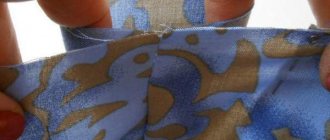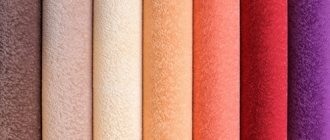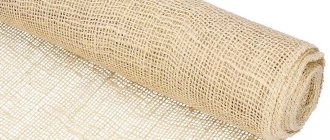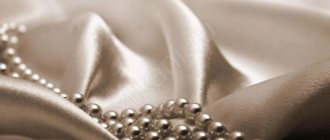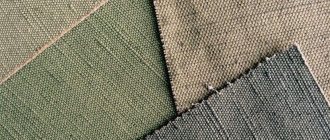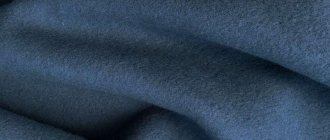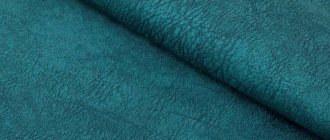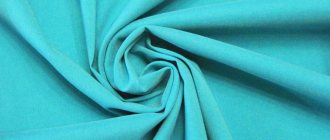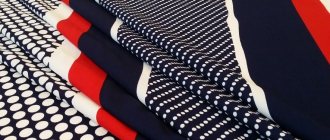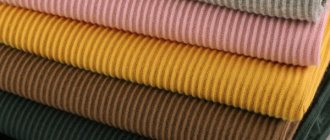Crash fabric is the name of a popular youth material with an unusual structure. Its entire surface is covered with folds, bruises and chaotic creases of various shapes. Its other names are reaper and crinkle. The history of crash began in the 80s of the last century. But modern fashion designers do not refuse to use it and use it for their collections.
What kind of fabric
Crash is the general name for fabrics that have an original wrinkled effect. The originality of the texture is achieved in several ways:
- the material undergoes heat treatment;
- the canvas is placed under a press;
- thread twisting technology is used;
- After heating, different fibers are combined into one fabric.
A combined option is often used - a press combined with hot processing. This production ensures the preservation of the relief for a long time.
An item made from such a fabric creates an attractive image, thanks to folds of various depths and directions. When moving, they reflect light, giving things an unusual shiny crash effect.
The crash material seems lush, voluminous and airy. In hot weather, it protects the body from overheating. Crinkled fabrics are ideal for slender women. Vertical folds highlight the figure favorably. At the same time, they will help women who are overweight to hide some imperfections.
How to care and store?
Despite the complex surface structure, caring for products made from the harvester is not difficult. Factory-produced natural and synthetic fabrics can be washed either by hand or in a washing machine. Delicate crinkled silk is best taken to the dry cleaner, but you can wash it by hand using cool water and mild detergents. At the same time, all the folds are secured with your hands and pressed out so that their direction is maintained. You should wash things from a homemade harvester in the same way. Synthetic crash can be machine washed, but it is advisable to twist the product into a rope and place it in a stocking or bag of the appropriate size.
Crinkled fabrics should not be ironed under any circumstances - unless the dress has become too tight for you and you want to increase its volume. To do this, the desired area of fabric is ironed through a wet cloth with an iron set at a temperature corresponding to the composition of the fabric. Folds that are too ironed can be moistened with water - a high-quality header will restore its surface. In order for things to retain their crinkled texture, it is better to store them by twisting them into a rope or knot and placing them in fabric covers.
Composition and properties
Crash is not just one type of material. Reaper can be called various types of fabric that have undergone special processing. Thin natural, synthetic, and mixed fabrics are used.
Crash fabrics contain:
- cotton;
- silk;
- linen;
- viscose;
- polyester.
Crash is amazing material. Treated fabrics such as satin, organza, chiffon, guipure, velor, satin, and calico look incredibly beautiful.
Velvet crash is a polyester-based fabric. Elastane adds additional properties to it.
Origin story
The reaper appeared in the 20th century in the 1980s and quickly found its fans. For the first time, crash was made from natural silk threads by twisting them multiple times and was called crepe. Both before and now, expensive clothes and luxury bedding sets are made from natural crepe due to its high cost.
The most commonly used crinkle is made from an inexpensive material containing various threads.
Reaper
What is known about the fabric header? What is its composition and properties?
more details
Crepe
What is a crepe type of fabric, what are its features, pros and cons?
more details
Advantages and disadvantages
The fabric has many advantages:
- mixed crash fabrics have a low price; viscose or synthetic fabrics are considered the most affordable;
- the material is unpretentious to use and washes quickly;
- does not require ironing;
- The thin header can be worn in hot weather due to good air exchange.
The header has almost no disadvantages. The only thing you need to know is some simple rules for caring for it. Otherwise, there is a risk of breaking the structure.
How is crinkled fabric made?
Most often, the crinkled effect is achieved by heat treating the fabric and placing it under a press. The material, heated in a special way, readily yields to strong pressure, and the folds are of different textures, from quite large to very small. Due to this, an airiness is created, an unusual radiant appearance, which makes a thing sewn from such fabric truly exclusive.
Not only some special fabrics can be pressed; synthetic, natural, and mixed fabrics can be pressed. Cotton, viscose, silk, linen, and polyester are in demand; harvesters made of lightweight, weightless fabrics—organza, chiffon, and guipure—are in particular demand. But thick jacket materials can also be processed very well; they look unusual and stylish.
The folds do not need to be very noticeable. Sometimes the crash effect is more like ripples on the water.
For example, there is a delicate effect of light ripples in the “adult” windbreaker model for girls G'n'K S-695. The texture creates relief and is unusually pleasant to the touch. And it fits perfectly into the style of the windbreaker - sporty, but gentle, a motif of modern romance for a lively, independent girl.
Or a boy's windbreaker S-696 made of jacket fabric with a crash effect. It is as durable as textureless jacket fabric, copes well with bad weather, protects from rain and chilly wind. And it looks – especially in combination with the ultra-fashionable logomania decor – very stylish.
Application area
The header made from natural fabrics is widely used in the manufacture of fashionable outfits. Crash dresses, skirts, blouses, as well as suits are based on a header. A crash wedding dress in blue and cream shades looks especially good. A velvet dress has a rich, noble look. Thin material is used to make summer clothes - sundresses, light skirts, trousers.
Crinkled velor or satin is suitable for the production of lambrequins for curtains. They give the room a special elegance and lightness. Country-style windows are also decorated with compressed linen curtains. Satin or velor bedspreads are used in the interior. Curtains are also made from the same crash fabric.
Accessories look great - especially scarves. Fashionable bed linen is made from knitwear.
Manufacturing and features
The description of crash fabric must begin with a description of its texture - the surface of the fabric is dotted with folds and wrinkles created artificially. They are arranged chaotically, have different sizes and depths - due to this, a truly unique effect is achieved. Creases appear under the influence of a special press; this method was developed back in the eighties of the last century.
There is no homogeneous composition, so it is impossible to definitively answer the question of what kind of crash material this is. This effect is successfully used on different fabrics - both synthetic and natural ones, made of cotton.
Thin materials - satin, organza or chiffon - look very impressive with crash. Looks great on silk and velvet. Actively used: guipure, velor, satin and crepe-satin, calico, linen and viscose, taffeta.
The manufacturer varies the composition depending on the product and its purpose! If you look at a photo of crash linen fabric, you can see how it differs from crinkled organza - but the folds remain unchanged. And here you can read about the properties of triacetate, look at the description of the material.
Where is this group of paintings used? You already know what kind of fabric is staple crash - or other varieties, which means you can guess the areas of use:
- Scarves and stoles;
- Dresses, skirts and trousers, sundresses;
- Lambrequins for curtains;
- Curtains and bedspreads;
- Bed sheets;
- Evening and wedding dresses.
It was worthwhile to carefully understand what kind of fabric is crepe crash or satin crash. Now you understand what things are really worth purchasing!
Pay attention to the composition - the seasonality and area of application of the products depends on the fabric. If you buy a velvet crinkle dress, you can wear it in the cold season - but linen crinkle sundresses are ideal for warm summers. Focus on your wishes!
Care
Crash material does not require special care. But certain rules must be followed:
- wash only in warm water by hand;
- you need to wring out the fabric carefully, to preserve the structure;
- Ironing the material is prohibited;
- keep things twisted, wrapped in a tight knot.
If the folds still lose their shape, then you need to wet the fabric again and twist it into a rope. Tie the ends, then dry as is. It's better to use a centrifuge.
Crash attracts with his style and creativity. Easy care and rich colors add to its popularity. Dressing up in clothes made from such material, you can be confident in your uniqueness.
Dear readers of the Tkan.Club website, if you still have questions on this topic, we will be happy to answer them. Leave your reviews, comments, share stories if you have dealt with this fabric! Your life experience may be useful to other readers.
DIY reaper
Great interest in crushed fabrics has been generated by a new type of hand-made materials - homemade crushed fabrics. In principle, any material can be subjected to this treatment, but strong folds at home can only be obtained on thin synthetic or mixed fabric. To create a crash effect you will need a piece of cloth and a microwave. The sequence of actions is as follows:
- The fabric is moistened in water at room temperature and wrung out properly.
- When squeezing, a piece of material is twisted into a tight strand along the grain thread (this operation is best performed by two people).
- The tourniquet will spontaneously curl into a spiral, from which a dense ball is formed.
- The ball is secured with cotton twine and placed in the microwave.
- The oven relay is set to minimum power and warmed up for four minutes, after which a pause of the same duration is made.
- To achieve the crash effect, five such cycles are performed (six for thick fabric mixed with cotton).
- The fabric must be dried without unrolling, preferably in the “drying” mode of the washing machine.
